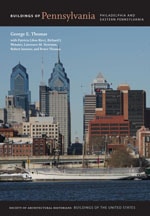
Day and Klauder continued the paired brick Flemish bond of the museum in the massive arcades of the university's football stadium. Franklin Field was erected on the site of the university's second stadium, built in 1895 and home in that spring of the first of the Penn Relays, long the nation's greatest amateur athletic track and field event, held annually in late April. It was rebuilt in 1922 to seat the many thousands who wanted to watch Penn's national powerhouse football teams and was nearly doubled with the construction of the upper deck three years later, bringing capacity to nearly seventy thousand. Ivy League football no longer draws such crowds, but it fills for the relays and it is still the best place in the nation to see a football game. The stadium is built of steel frame with concrete decking, and without expansion joints, which would not become common until a few years later. Weightman Hall infills the open end of the field. Penn's first purpose-built gymnasium, it was the work of Frank Miles Day and Brother in 1903, who adapted an industrial steel roof to span the gymnasium.

